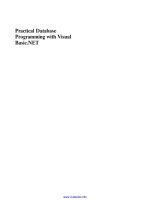Lecture Learning programming using Visual Basic Net – Chapter 3 Representing data Constants and variables
Bạn đang xem bản rút gọn của tài liệu. Xem và tải ngay bản đầy đủ của tài liệu tại đây (89.03 KB, 43 trang )
CHAPTER THREE
Representing Data: Constants
and Variables
Chapter Introduction
3- 2
• Compose event procedures that perform more
sophisticated tasks.
• Focus specifically on data items.
• Continue work with Visual Basic .NET project
structure.
• Determine the meaning of the term scope.
McGraw-Hill/Irwin
©2002 by The McGraw-Hill Companies, Inc. All
rights reserved.
Objectives
3- 3
• Differentiate between numeric and string data.
• Determine whether a data item should be a
constant or variable.
• Code constants and variables in event
procedures.
• Describe the characteristics and uses of
standard data types.
• Create projects that consist of several forms.
• Explain scope and describe the domain of
variables in procedures and forms.
McGraw-Hill/Irwin
©2002 by The McGraw-Hill Companies, Inc. All
rights reserved.
3.1 Data Categorization
3- 4
• Two broad categories of data are numeric and
string.
– Numeric data must contain only numbers.
– String data can contain any symbol.
– Numeric data is used in arithmetic
calculations.
– String data cannot be used in calculations.
McGraw-Hill/Irwin
©2002 by The McGraw-Hill Companies, Inc. All
rights reserved.
3.2 Constants
3- 5
• Data item whose value is assigned at design
time and remains the same at run time.
• A literal constant is just a value.
• A symbolic constant is a descriptive name
substituted for a literal constant.
McGraw-Hill/Irwin
©2002 by The McGraw-Hill Companies, Inc. All
rights reserved.
3.2 Constants (cont.)
3- 6
• Four different kinds of constants:
– Numeric literal.
– String literal.
– Numeric symbolic.
– String symbolic.
McGraw-Hill/Irwin
©2002 by The McGraw-Hill Companies, Inc. All
rights reserved.
Literal Constants
3- 7
• Writing Numeric Literal Constants
– Ex. 3.45 +231 .1 9.4E+7
• Writing String Literal Constants
– Ex. “Hello Jean”
• Symbolic Constants
– INTERESTRATE represents 0.045.
• Creating/Choosing Symbolic Constant Names
– Names are chosen by the developer.
– Naming rules must be adhered to.
McGraw-Hill/Irwin
©2002 by The McGraw-Hill Companies, Inc. All
rights reserved.
Literal Constants (cont.)
3- 8
• The Constant Definition Statement
– Ex. Const INTERESTRATE = 0.045
• Run Time: How the Computer Uses Symbolic
Constants
– Stored in a reference table for later use.
McGraw-Hill/Irwin
©2002 by The McGraw-Hill Companies, Inc. All
rights reserved.
Literal Constants (cont.)
3- 9
• Advantages of Using Symbolic Constants
– Make program easier to understand.
– Reduce the chance of program
inconsistencies.
McGraw-Hill/Irwin
©2002 by The McGraw-Hill Companies, Inc. All
rights reserved.
Literal Constants (cont.)
• Literal versus Symbolic Constants
– The null string (“”) and numeric data used in
formulas should be the only literal constants.
• Typical Uses of Symbolic Constants
– Prime interest rate.
– Overtime rate.
– Number of print lines for a printed page.
McGraw-Hill/Irwin
©2002 by The McGraw-Hill Companies, Inc. All
rights reserved.
310
Literal Constants (cont.)
• Predefined Symbolic Constants
– Visual Basic .NET contains a large set.
– Contained in classes, such as the Math and
Color classes.
McGraw-Hill/Irwin
©2002 by The McGraw-Hill Companies, Inc. All
rights reserved.
311
3.3 Variables
•
•
•
•
•
FleetSize
WageRate
AverageAge
MaximumCapacity
NumberOfSeminar
Participants
• EmployeeName
McGraw-Hill/Irwin
•
•
•
•
•
•
NumBidUnits
YtdEarnings
EmployeeNumber
ExtendedPrice
Depreciation
X
©2002 by The McGraw-Hill Companies, Inc. All
rights reserved.
312
Standard Data Types
• Number of Bytes
– Main memory occupied by a variable.
• Range
– Largest and smallest values that can be
stored in a numeric variable of a given type.
McGraw-Hill/Irwin
©2002 by The McGraw-Hill Companies, Inc. All
rights reserved.
313
Standard Data Types (cont.)
• Precision
– Indicates how close together two numeric
values can be.
• Speed of Arithmetic Calculation
– Differs for the different data types.
McGraw-Hill/Irwin
©2002 by The McGraw-Hill Companies, Inc. All
rights reserved.
314
Choosing the Best Data Type
for a Variable
• Use decision rules
– Ex. Boolean is the best type for a variable that
may be true or false.
– Ex. Decimal is the best type for a dollar
amount.
McGraw-Hill/Irwin
©2002 by The McGraw-Hill Companies, Inc. All
rights reserved.
315
Declaring Variables:
The Dim Statement
• A variable declaration statement.
– Examples:
•
•
•
•
•
Dim StreetAddress As String
Dim GrossWeight As Integer
Dim HomePhone As String
Dim NetIncome As Decimal
Dim CurrentStudent As Boolean
McGraw-Hill/Irwin
©2002 by The McGraw-Hill Companies, Inc. All
rights reserved.
316
Using Variables:
The Assignment Statement
• Syntax of the Assignment Statement
– variablename = expression
• Ex. CourseCode = “CISB119”
• Run Time: The Effect of the Assignment
Statement
– Evaluates expression on right side of equal
sign.
– Stores value of expression in variable on left
side of equal sign.
McGraw-Hill/Irwin
©2002 by The McGraw-Hill Companies, Inc. All
rights reserved.
317
Using Variables:
The Assignment Statement (cont.)
• Run Time: How the Computer Evaluates
Expressions
– Computer determines the identity of each
component of the expression.
– Computer performs the indicated operations
to calculate a value.
McGraw-Hill/Irwin
©2002 by The McGraw-Hill Companies, Inc. All
rights reserved.
318
Using Variables:
The Assignment Statement (cont.)
• Changing Variable Values during Execution
– Storing a value in a variable will overwrite any
existing value.
• Assignment Statements with Strings
– To store the result of string manipulations in
string variables.
McGraw-Hill/Irwin
©2002 by The McGraw-Hill Companies, Inc. All
rights reserved.
319
Using Variables:
The Assignment Statement (cont.)
• The Type Mismatch Error
– Trying to store string data in a numeric
variable.
• The Try/Catch Block
– Used to detect and handle errors that are
encountered during run time.
McGraw-Hill/Irwin
©2002 by The McGraw-Hill Companies, Inc. All
rights reserved.
320
Using Variables:
The Assignment Statement (cont.)
• Control Properties in Assignment Statements
– Ex. lblHomePrice.Text = 210000
• Why Use Variables
– Ideal to store results of intermediate
calculations.
– Values stored in variables may be retrieved
and formatted.
McGraw-Hill/Irwin
©2002 by The McGraw-Hill Companies, Inc. All
rights reserved.
321
Option Explicit
• Removes the requirement to declare all
variables.
• Highly recommended that this option is ON.
• Helpful in reducing typographical errors.
McGraw-Hill/Irwin
©2002 by The McGraw-Hill Companies, Inc. All
rights reserved.
322
3.4 The Windows Form Control
• Background of our user interface.
• Organizes a project.
McGraw-Hill/Irwin
©2002 by The McGraw-Hill Companies, Inc. All
rights reserved.
323
Appearance and Use
• Multiple forms may be used for large projects.
– Each form should represent an objective.
– Each form should be clear and attractive.
• Each form is a user interface window during run
time.
• All forms have the same basic components.
McGraw-Hill/Irwin
©2002 by The McGraw-Hill Companies, Inc. All
rights reserved.
324
Properties of the Form Control
•
•
•
•
•
(Name)
AcceptButton
BackColor
CancelButton
ControlBox
McGraw-Hill/Irwin
•
•
•
•
Font
MaximizeBox
MinimizeBox
Text
©2002 by The McGraw-Hill Companies, Inc. All
rights reserved.
325









